In our various materials on creating good learning designs in OLab, we have spoken much about branching narratives in case designs. The ability to create such branching designs is a powerful feature of OLab but not all authors make good use of this capability.
The important principle that we try to convey is about decisions and consequences. Real life is not like a quiz: if you make the wrong choice, there is no little man who jumps out of the bushes with a wee red flag to tell you that you made the wrong choice. You have to live with the consequences of your decision.
This is certainly not a hard concept to grasp. But it is harder to incorporate into your scenario design. So here are a few examples to consider when trying to adopt this approach:
- Sarah-Jane Pritchard – early case. Keep her alive.
- Princess & Dragon – is the branching sufficiently obvious in this one? I think so
- Cultural Competencies
- Lackadaisical Larry
- Virtual Triage
- Suturing – hub spoke ref model
- Dig Prof – hub spoke ref model
- Medical Careers – extreme example
Sarah-Jane Pritchard
Sarah-Jane is a wonderfully simple, yet challenging case, first created by Jonathan Round at SGUL, using an early version of OLab2. It is very plain, with only text, no images. But it is also powerful: right from the start, it is obvious that all the choices have reasonable options. But some are more effective than others. Try out our local version of this excellent case. The challenge is to keep her alive. If you don’t move swiftly, she will perish.
Princess and the Dragon

This is a tongue-in-cheek short fairy tale that we created to illustrate some simple features in OLab3. Again, there are only a few decisions to make but the case plays out differently depending on the choices you make.
This is a screenshot of the node layout in the Visual Editor to give you a rough idea of how the design progresses. Start is green; two decision points in yellow; end nodes in red.
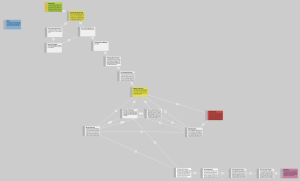
Cultural Competencies and Lackadaisical Larry
These are two scenarios that we created that illustrate the use of virtual learners. Instead of dealing with a virtual patient, the scenario revolves around dealing with the behaviours of various maladaptive learners. Both scenarios have many different choices and evolve differently, depending on those choices. Indeed, with Larry, if you are too soft on him, he gets worse and worse in his behaviours. But he fights back if you are too rigid. A tough case to negotiate.
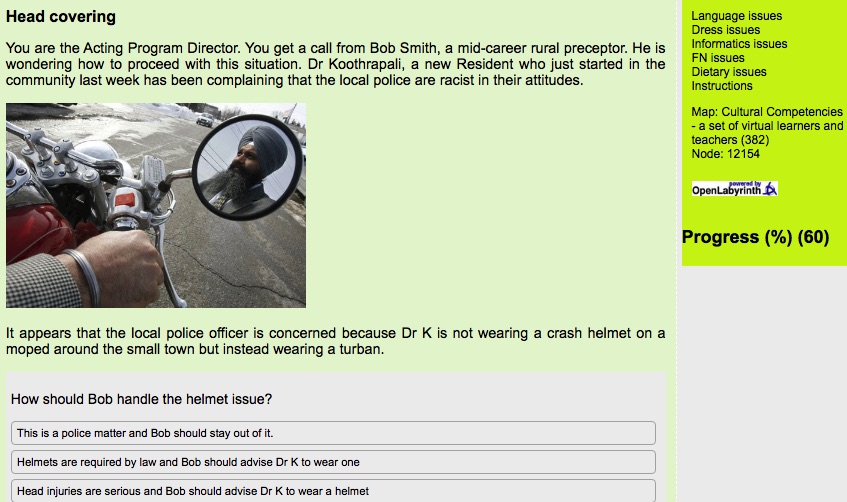
Cultural Competencies – a series of virtual learners and situations
Lackadaisical Larry – a challenging learner with difficulties
Virtual Triage
This is a case that we first created in OLab2 and then migrated to OLab3. There are 3 victims in a motor vehicle accident. Your job is to triage them correctly and try to save their lives. Your decisions at each stage will have different consequences; you cannot save them all.
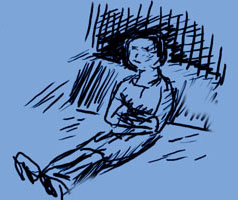
Here is a screenshot from the Visual Editor in that case:
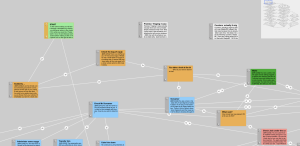
This is a much more complex case than the Princess and Dragon scenario. We apologize that we cannot do justice to the screenshot. You can get a sense of how things are laid out by examining the thumbnail view in the top right corner of the image. You can see three columns of nodes, representing the various actions that you can take on each of the three patients that you are trying to save.
Reference scenarios
Another map design that we occasionally use is the hub and spoke model. For reference materials, where it is not important if the user navigates the sections in a particular order, this can be very useful. In general, this is very similar to a general wiki design: a main page with sub-sections. And it will appear so when played.
The key difference when doing this in OLab is that it is much easier to control access to certain more advanced sections, and there is much better tracking of where your user spent their time or what they found interesting.
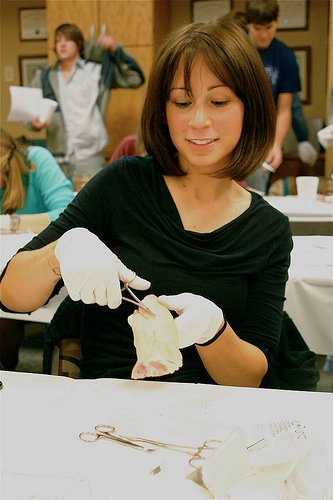
Suturing – a simple reference manual on suture techniques
Digital Professionalism – a map, broken into sections (some constrained and some not)
Medical Careers
We also have an example of a very complex design. The Medical Careers scenario is a game for medical students, based on the board game careers. Just as in the original board game, players take it in turns to roll the dice and choose the career paths that they want to explore. Also, as in the original game, you are trying to win by finding the ideal combination of health, wealth and reputation.

This is an example of an early map design. Visually, it is quite similar to the board game. This visual layout helped enormously when mapping out the complexities of the case.

With 260 nodes, 739 links, and Rules running to hundred of lines, this is a bit of an extreme example. It took hundreds of hours of work to complete. But it does illustrate the power of what you can do with OLab.

